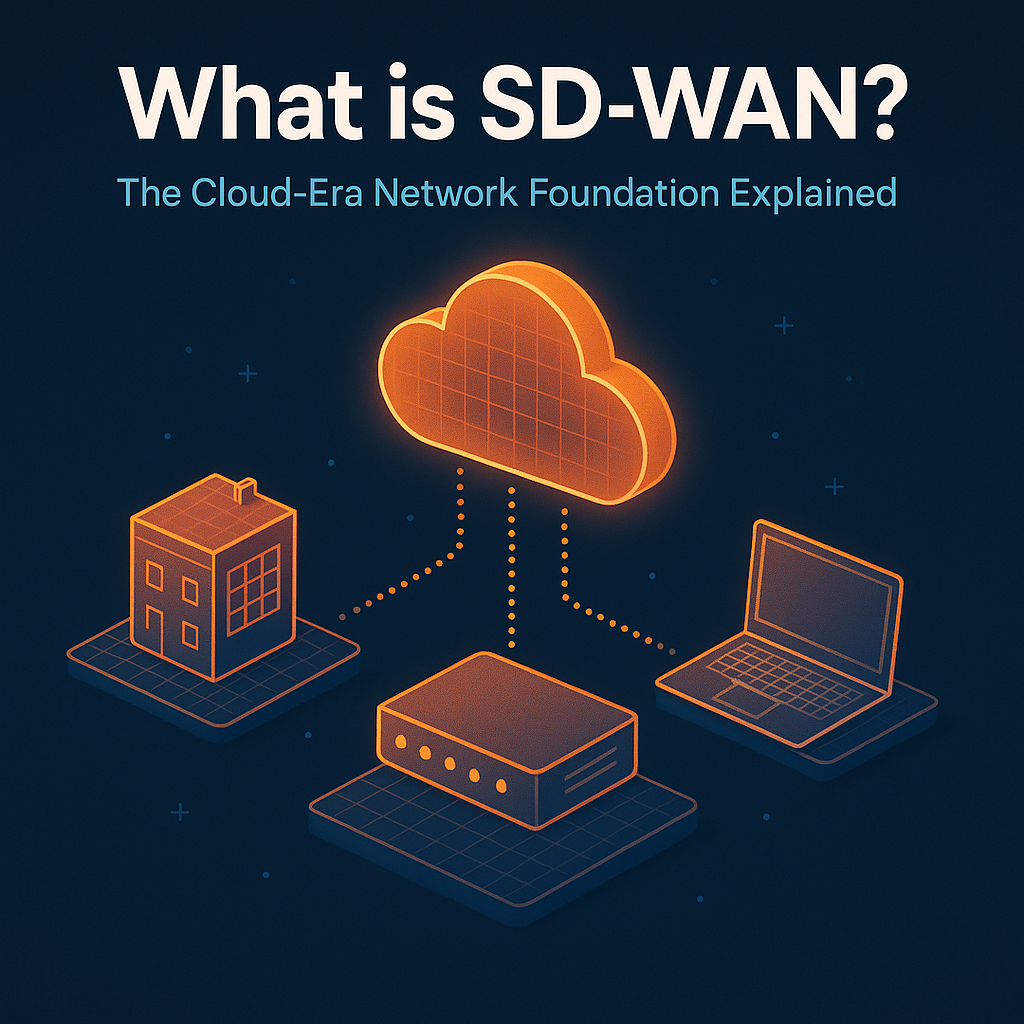In today’s cloud-powered, app-driven, and remote-first environment, the way businesses connect users to applications has fundamentally changed. Traditional WAN architectures, built around centralized data centers and MPLS links, simply can’t keep up with the distributed nature of today’s work. Latency, complexity, and cost all skyrocket. Enter: SD-WAN.
So, what is SD-WAN?
SD-WAN, short for Software-Defined Wide Area Network, is a smarter, software-driven approach to managing enterprise WAN infrastructure. It provides centralized control, dynamic path selection, application awareness, and increased flexibility—across multiple transport types (MPLS, broadband, LTE/5G). Built for agility and the cloud, it empowers businesses to be faster, more secure, and dramatically more efficient.
This guide will break down the fundamentals, architecture, use cases, benefits, and future of SD-WAN in a real-world context.
Key Takeaways
- SD-WAN = Software-Defined Wide Area Network, using software-defined policies for smarter connectivity across diverse transport types with real-time adaptability and control.
- Provides centralized orchestration, dynamic routing, and app-level visibility across WAN links, enabling consistent policy enforcement and adaptive response to network conditions.
- Offers better application performance, reduced costs, and improved security through intelligent traffic steering, encryption, and integrated threat detection.
- Designed to serve cloud-based workflows, SaaS-heavy environments, remote teams, and edge computing, while improving reliability, scalability, and operational efficiency.
- SD-WAN is the foundational layer for advanced architectures like SASE and Zero Trust, delivering the visibility, context, and enforcement framework they rely on.
What is SD-WAN?
SD-WAN stands for Software-Defined Wide Area Network. At its core, it decouples the network control function from the forwarding function, allowing network administrators to manage WAN traffic from a centralized interface.
In traditional WANs, routing decisions are tied to physical devices—hardware routers with static paths. In contrast, SD-WAN adds a control layer that intelligently directs traffic based on application type, current network conditions, and predefined policies.
Instead of relying solely on expensive, dedicated MPLS circuits, SD-WAN can combine broadband, LTE, and even satellite links to create virtual WAN overlays that dynamically respond to user demands.
Why is this important? Because businesses no longer operate out of a single HQ. Teams work from everywhere. Apps live in the cloud. And the WAN needs to keep up.
How SD-WAN Works
SD-WAN functions by intelligently abstracting and managing the network connectivity between enterprise branches, data centers, and cloud services. Instead of relying on static, point-to-point hardware-defined paths, SD-WAN uses a virtual overlay network built on top of any available transport—broadband, LTE, MPLS, or satellite.
Here’s a look at the essential components and behaviors that make SD-WAN so effective:
- Centralized Orchestration: Admins define granular, business-driven policies in a single cloud-based interface and push them network-wide. This removes the need for manual CLI configuration on a per-device basis.
- Real-Time Traffic Monitoring: The SD-WAN edge constantly probes available paths for latency, jitter, and packet loss. It collects telemetry and feeds it into a feedback loop that dynamically selects the best path for each flow.
- Policy-Based Routing: Application traffic is classified and directed based on predefined intent. Voice and video traffic can be prioritized over general web traffic. Backup or large file transfers can be routed during low-utilization windows.
- Application Awareness: Unlike traditional QoS tagging, SD-WAN recognizes applications at Layer 7, enabling precise traffic shaping, throttling, or prioritization based on business value.
- Encrypted Tunneling and Segmentation: Traffic is encapsulated within IPSec or SSL tunnels. SD-WAN also supports segmentation, separating traffic between departments, users, or applications.
Together, these capabilities produce a WAN that’s agile, adaptive, and tuned to support real-world conditions—especially those involving hybrid cloud, SaaS, and globally distributed users.
Traditional WAN vs SD-WAN
Feature | Traditional WAN | SD-WAN |
Primary Transport | MPLS | MPLS, Broadband, LTE, Satellite |
Flexibility | Low | High |
Cloud Optimization | Minimal | Native |
Security | External Firewall | Integrated |
Deployment Speed | Weeks | Hours |
Cost Efficiency | Low | High |
Resilience | Rigid | Dynamic failover |
Why SD-WAN wins: It breaks the dependency on rigid architectures. It enables direct-to-cloud paths, reduces backhaul latency, and supports real-time app needs without blowing up your budget.
Core Components of SD-WAN
Every SD-WAN deployment is built on a set of key architectural components that work in concert to deliver a virtualized, intelligent, and secure wide-area network. Understanding how each of these elements works—and how they interact—is critical for designing a high-performing SD-WAN solution that supports diverse applications, multiple transport types, and dynamic business needs.
- Edge Devices: These are the branch routers or customer-premises equipment (CPE)—physical or virtual—that sit at the edge of each site. They are responsible for classifying traffic, enforcing policies, terminating encrypted tunnels, and providing first-line analytics. Some vendors offer edge devices with built-in firewall and WAN acceleration capabilities.
- SD-WAN Controller: This is the central policy engine and control layer. It defines business intent, distributes configurations, monitors global network health, and reacts to telemetry. Typically cloud-hosted, it provides the single pane of glass for IT teams managing complex WAN environments.
- Data Plane: This is the operational layer that actually moves packets from one place to another. It consists of encrypted overlay tunnels established between edge devices, allowing secure and segmented communication across public and private transports.
- Control Plane: The intelligence layer of SD-WAN. It makes decisions about routing, quality of service (QoS), link selection, failover, and re-authentication. In most modern architectures, this layer is centralized but may have distributed elements for redundancy.
- Transport Independence: SD-WAN solutions are designed to treat all types of underlying connectivity—MPLS, broadband, LTE, 5G, satellite—as equal citizens in the overlay. This abstraction allows for path steering and failover based purely on performance metrics, rather than link type.
Understanding these components allows network architects to better evaluate vendor capabilities, plan deployments, and anticipate how SD-WAN will integrate with existing infrastructure, security stacks, and cloud platforms.
Key Benefits of SD-WAN
Let’s go beyond the basics and quantify the impact:
- Performance Optimization: Up to 70% improvement in application response time through intelligent path selection.
- Reduced Network Costs: 30–50% savings on bandwidth by replacing or augmenting MPLS with broadband.
- Zero-Touch Provisioning: Bring up a new site in minutes with preconfigured templates.
- Integrated Security: Encrypted tunnels, application-level segmentation, and built-in firewall capabilities.
- Cloud-Native Alignment: Provides direct breakout to cloud apps, with per-app steering and local QoS enforcement.
- Improved User Experience: Lower jitter, reduced packet loss, and seamless failover enhance productivity.
Common Use Cases
- Retail and Franchise Branching: Securely connect 100s or 1,000s of stores with consistent performance.
- Remote Worker Enablement: Deliver office-like performance and security to home networks.
- Cloud Connectivity Optimization: Bypass data center bottlenecks with direct access to cloud apps.
- Disaster Recovery and Failover: Maintain availability by shifting traffic in sub-second timeframes.
- Temporary and Pop-Up Sites: Deploy connectivity using LTE/5G within hours, not days.
- IT Consolidation: Simplify post-M&A network merging through overlay configuration, not physical rewiring.
SD-WAN in Action
SD-WAN and Cloud Services
Most enterprise traffic no longer goes to the data center—it goes to the cloud.
SD-WAN understands this. It enables direct, secure connections to SaaS providers and public cloud platforms (AWS, Azure, GCP), skipping unnecessary backhauls and improving latency by 20–50% in some cases.
For Microsoft 365, Google Workspace, Salesforce, and Zoom—every millisecond matters. SD-WAN detects the app and ensures it takes the best path.
SD-WAN Security Features
Security is baked in, but more importantly, it’s context-aware and dynamically enforced. Here’s how SD-WAN enhances security in a practical, operationally scalable way:
- End-to-End Encryption: IPSec or SSL tunnels protect all traffic—whether it traverses public internet or private backbones. Encryption policies can be centrally managed and updated as needed.
- Integrated Firewall: Many SD-WAN solutions offer built-in NGFW (next-gen firewall) capabilities, allowing deep packet inspection and enforcement of granular app-layer policies without separate appliances.
- ZTNA and Identity Awareness: SD-WAN can enforce policies based on user identity, device compliance, location, and time of day. It integrates with directory services and identity providers for policy enforcement tied to context.
- Micro-Segmentation: Administrators can define multiple trust zones within the same physical network. East-west traffic can be isolated based on app or department, dramatically limiting lateral movement in case of breach.
- Automated Threat Response: Telemetry from SD-WAN feeds into SIEM and SOAR platforms. If an anomaly is detected (e.g., a sudden flood of VoIP packets from a branch), automated workflows can reroute, quarantine, or alert in real time.
SD-WAN is more than secure connectivity—it’s adaptive security enforcement at the network edge, designed for the realities of modern, distributed IT.
SD-WAN and SASE
SASE—Secure Access Service Edge—combines SD-WAN’s agility with cloud-delivered security.
In a SASE framework, SD-WAN provides the transport and context, while security services (SWG, CASB, ZTNA, FWaaS) inspect and enforce policy at the edge.
No SD-WAN, no SASE. Without efficient routing and telemetry, SSE can’t function optimally. SD-WAN is the nervous system; SASE is the whole body.
Challenges of SD-WAN
Even the best tech has its hurdles—and SD-WAN is no exception. For all its benefits, real-world deployment demands strategic alignment, architectural clarity, and operational readiness:
- Initial Planning: SD-WAN requires detailed understanding of application behavior, user locations, and traffic priorities. Misaligned policies or vague business intent can lead to performance issues or inefficient routing.
- Vendor Fragmentation: Feature sets vary widely between vendors. Some offer basic overlay routing, while others deliver full SASE integrations. A rushed decision can leave you locked into a platform that lacks future-proof capabilities.
- Complexity at Scale: Managing one branch is easy. Managing 100 across different time zones with overlapping policies, security domains, and cloud breakouts introduces real architectural complexity.
- Skill Gaps: SD-WAN requires knowledge across networking, security, and orchestration. Many organizations face internal training gaps or rely too heavily on vendors without fully understanding their deployment.
- Integration Overhead: Aligning SD-WAN with firewalls, DNS, identity providers, SIEM, and cloud access brokers can be non-trivial. Especially when deploying Zero Trust or hybrid SASE environments.
The ROI is worth it—but only when paired with deliberate design, clear ownership, and active lifecycle management.
The Future of SD-WAN
Looking ahead:
- AI-Driven Optimization: Predict congestion, reroute traffic before users notice.
- 5G Native Support: Integrated SIM-based redundancy at the edge.
- Edge Compute Integration: Run apps/services directly on SD-WAN appliances.
- Secure Edge Fabric: Merge SD-WAN with container-native services and SASE policies.
- SD-WAN as-a-Service (SDWaaS): Consume SD-WAN entirely via cloud with zero infra overhead.
SD-WAN will continue to evolve from a WAN overlay to a foundational platform for everything edge.
Final Thoughts
What is SD-WAN? It’s more than just a better way to connect sites—it’s the intelligent foundation for secure, cloud-optimized, user-centric networking.
As networks shift from centralized data centers to edge-first, cloud-native architectures, SD-WAN is the technology enabling that transformation.
If you’re planning for a future of distributed work, SaaS dependency, and performance-sensitive applications, SD-WAN is no longer optional—it’s mission-critical.
Know the architecture. Know the value. Build better networks.





